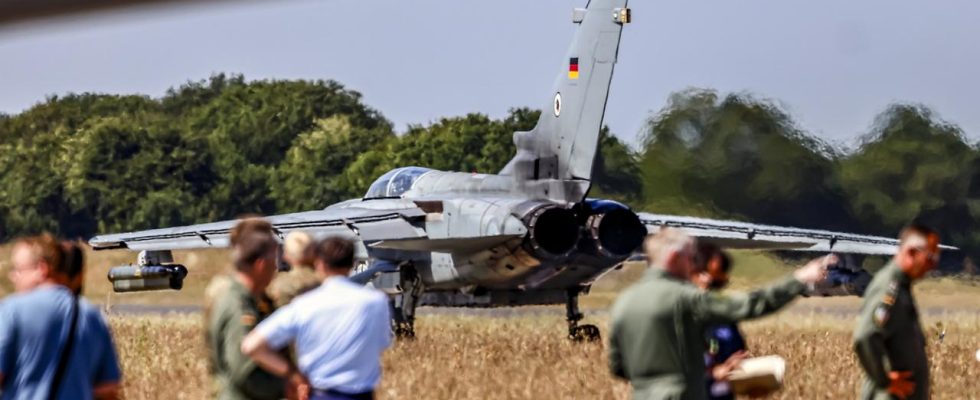faq
The largest air force exercise in the history of NATO has begun in German airspace. What is the “Air Defender” maneuver about? What is the criticism? And is that why there are flight delays?
What is the purpose of the exercise?
In the case of major military maneuvers, the planners often create a scenario that is fictitious but appears as realistic as possible. This is also the case here: An eastern military alliance with the fantasy name “OCCASUS” already controls parts of Germany and now wants to conquer the port of Rostock with special forces. The Allied troops try to repel this attack.
This is a fairly sophisticated exercise scenario that the planners came up with: the population has been weakened by the corona pandemic, energy reserves are running out, the enemy is taking sabotage actions. All of this has been developed as a scenario over the past two years. Russia is not explicitly mentioned, and NATO repeatedly emphasizes that the large-scale exercise is purely defensive and not directed against Moscow. However, the exercise scenario has seemed even more realistic to many European allies since February 24, 2022 – the start of the war in Ukraine – i.e. before that date.
What exactly is trained?
The Buddhist motto “The path is the goal” also applies at least in part to “Air Defender”: The relocation of personnel, material and kerosene – sometimes thousands of kilometers across the Atlantic – is part of the exercise.
Various things are played through during the actual maneuver: air refueling, intercept exercises – in other words, what friendly nations in the Baltic States and over the Baltic Sea regularly do anyway when Russian jets fly too close to NATO airspace. Of course, air combat is also trained. But no provocative flights in the direction of Kaliningrad, which borders on the Baltic States and belongs to Russia, as the German air force inspector Ingo Gerhartz had repeatedly emphasized.
Who participates?
Even if it is the “largest relocation exercise of air forces in the history of NATO” – “Air Defender” is expressly not a NATO exercise, but an air force maneuver under “German leadership”.
At the same time, almost all of the 25 participating nations are members of NATO, with the USA leading the way. Also included: Japan. A total of 250 aircraft have been relocated to Germany, 100 of them from the USA alone. 2,000 flights are planned and 10,000 soldiers will be involved.
Where exactly does the maneuver take place?
During the “Air Defender” maneuver, the transfer of aircraft is also practiced, for example from the USA to Germany. This relocation of fighter jets and transport aircraft across the Atlantic has been underway since the end of May.
In total there are three main hubs for air traffic. The fighter jets in particular take off from Jagel/Hohn in Schleswig-Holstein and Lechfeld in Bavaria. The Wunstorf Air Base in Lower Saxony is the logistics center. Transport machines will take off and land from here every day, for material transport, for parachutists or for aerial refueling of the fighter jets.
25 countries (green; USA and Japan not shown) are taking part in the “Air Defender 23” air force exercise. The maneuver mainly takes place in three airspaces (shaded). There are also flights to NATO’s eastern border.
The military exercise will affect most of German airspace. In the north, flights are made over the North Sea, Schleswig-Holstein and Lower Saxony. The exercise area south mainly affects Bavaria, Baden-Württemberg and Rhineland-Palatinate. Up to 40 machines will be in the air at the same time during the training sessions.
In the east, exercises are carried out over the Baltic Sea, Mecklenburg-Western Pomerania and parts of Saxony. Especially around Rostock it could get loud. Here an attack on the port is to be simulated. Planned are low-level flights up to a height of 330 meters. This corresponds to the usual standards in Germany.
When is training?
The burden on the population from the two-week maneuver should be kept as low as possible. The military therefore tries to fly primarily over sparsely populated areas and only at certain times of the day. Flights are to take place between 10 a.m. and 2 p.m. in the east exercise room, between 1 p.m. and 5 p.m. in the south exercise room and between 4 p.m. and 8 p.m. in the north exercise room. According to the Bundeswehr, no practice flights will take place at night or on weekends.
What does this mean for civil aviation?
In order to minimize the burden on civil aviation, the “Air Defender” maneuver will be held between the end of the Whitsun holidays in some federal states and the beginning of the summer holidays. The Air Force and air traffic control have been simulating possible restrictions from the maneuver for months. But the assessment of the possible consequences for civil air traffic is completely different.
The Bundeswehr relies on the last simulation by the European aviation security authority Eurocontrol. Accordingly, no flight cancellations, but only individual delays in civil air traffic are to be expected.
The capital’s airport BER, for example, expects delayed flights. In individual cases, it should then be checked whether, at the request of the airlines, take-offs and landings outside of operating hours are possible. Delays up to 1:00 a.m. are conceivable. There should also be exceptions to night flights at the airports in Stuttgart, Hamburg and Düsseldorf. Late take-offs up to midnight are permitted at Frankfurt Airport.
What does the exercise have to do with the Russian war of aggression against Ukraine?
The German air force inspector Ingo Gerhartz came to the USA five years ago with the idea for “Air Defender”. So after Russia’s capture of Crimea, but well before the start of the large-scale attack on Ukraine.
In other words: “Air Defender” would have taken place without the Russian war of aggression, but now it has a new meaning and can also be justified much more easily. In short: “Air Defender” was always intended as a deterrent, and that is even more true today. Or as Gerhartz put it:
Showing now that we are capable of defending this alliance, this country, is of course a very important signal.
Why is the US so heavily involved?
The US also wants to send a signal of deterrence, also in the direction of the Kremlin – that’s obvious. At the launch of “Air Defender” in Berlin, US Ambassador Amy Gutmann said she would be surprised if any leader in the world failed to see what this exercise “demonstrates in terms of the spirit and strength of this alliance”. And she added: “That includes Mr. Putin.”
And another signal should come from the fact that the USA is so strongly represented: They are not withdrawing from Europe, on the contrary. And that after it looked like under ex-President Barack Obama that America would now turn primarily to China, Asia and the Pacific. More USA in Europe – Putin has also achieved this with his war of aggression.
What criticism is there of the maneuver?
There are at least critical questions – such as: How much does this mega maneuver cost? The Bundeswehr is silent on official demand. And points out that you can only say that afterwards.
The question also resonates as to what climate footprint the exercise with this huge kerosene consumption leaves behind, as far as one can speak of a “footprint” in the air. “Security doesn’t come for free,” was the Air Force’s response.
And then there is also the question of whether that is not a provocation towards Russia, whether it is not an escalation step. There is a very clear answer to that: There can hardly be a bigger escalation than the attack of a defensive neighboring country.


